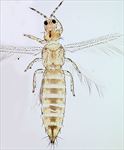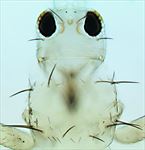
Female

Head & thorax

Females - winged and wingless

Female aptera

Female & male

Female

Male and female

Common pest form

Female

Head & pronotum

Head

Tergites

Tergites VII-VIII

Fore wing
Link to genera & species of Australian Thripinae
Diagnostic characters
This subfamily is considered paraphyletic with relation to the other three Thripidae subfamilies (Zhang et al., 2019). The members exhibit a wide diversity of size, colour and structure, including the number of antennal segments, the chaetotaxy of the fore wings and sternites, and the presence on the tergites of specialised rows of microtrichia (ctenidia) that are probably associated with retaining the wings at rest.
Diversity
About 1750 species in 230 genera are listed in the Thripinae worldwide (ThripsWiki, 2020), with about 230 species in 58 genera recorded from Australia (ABRS, 2020).
Distribution data
Species of this subfamily are found worldwide wherever green plants can grow, from the Arctic regions in the North to Kerguelen Island in the sub-antarctic.
Biological data
Many species breed in flowers, particularly in temperate areas such as Europe, but other species breed on leaves, often on young emerging flush leaves. Many species breed only on Poaceae, a few species are predatory on leaf mites, and some are associated with mosses or ferns.
References
Australian Biological Resources Study. https://biodiversity.org.au/afd/taxa/Thripinae/statistics
ThripsWiki (2020) ThripsWiki - providing information on the World's thrips. Available from: http://thrips.info/wiki/Main_Page [accessed 29.x.2019].
Zhang SM, Mound LA & Feng JN (2019) Morphological phylogeny of Thripidae (Thysanoptera: Terebrantia). Invertebrate Systematics 33: 671-696.